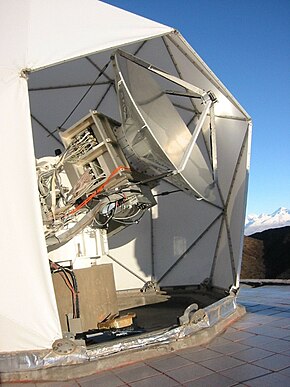 The SST during a maintenance procedure with the radome open. The SST during a maintenance procedure with the radome open. | |
| Alternative names | SST |
|---|---|
| Part of | Leoncito Astronomical Complex |
| Location(s) | San Juan Province, Argentina |
| Coordinates | 31°47′56″S 69°17′48″W / 31.79897°S 69.29669°W / -31.79897; -69.29669 |
| Organization | Leoncito Astronomical Complex Mackenzie Presbyterian University |
| Altitude | 2,491 m (8,173 ft) |
| Wavelength | 212, 405 GHz (1.414, 0.740 mm) |
| Built | 1995–1999 (1995–1999) |
| First light | April 1999 |
| Telescope style | Cassegrain reflector radio telescope |
| Diameter | 1.5 m (4 ft 11 in) |
| Enclosure | radome |
| Website | www |
 | |
| [REDACTED] Related media on Commons | |
| [edit on Wikidata] | |
The Solar Submillimeter Telescope (SST) is a solar dedicated instrument with the aim to study the radiation produced by high-energy particles during solar flares. Observing at 212 and 405 GHz with a focal array since 2001, it is a unique instrument that has produced a wealth of new information. Some of its discoveries are still unexplained by current theories. SST construction started in 1995, and it saw the first light in April 1999; since April 2001 it operates on a daily basis. It is installed at Complejo Astronomico El Leoncito (San Juan Province, Argentina) under agreement between the Argentinian National Scientific and Technical Research Council (CONICET) and the Brazilian Universidade Presbiteriana Mackenzie.
References
- Krucker; et al. (23 March 2013). "Solar flares at submillimeter wavelengths" (PDF). The Astronomy and Astrophysics Review. 21: 58. Bibcode:2013A&ARv..21...58K. doi:10.1007/s00159-013-0058-3. S2CID 122332534.
This article is a stub. You can help Misplaced Pages by expanding it. |